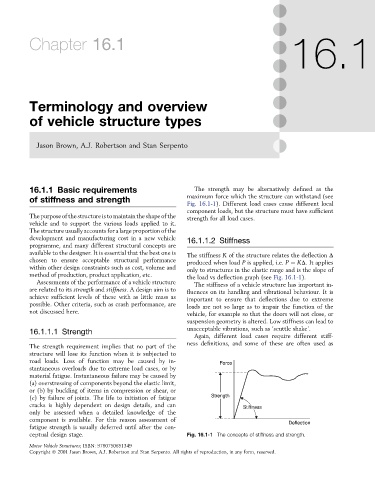Page 518 - Automotive Engineering Powertrain Chassis System and Vehicle Body
P. 518
16.1
Chapter 16.1
Terminology and overview
of vehicle structure types
Jason Brown, A.J. Robertson and Stan Serpento
16.1.1 Basic requirements The strength may be alternatively defined as the
maximum force which the structure can withstand (see
of stiffness and strength
Fig. 16.1-1). Different load cases cause different local
component loads, but the structure must have sufficient
Thepurposeofthestructureistomaintaintheshapeofthe strength for all load cases.
vehicle and to support the various loads applied to it.
The structure usually accounts for a large proportion of the
development and manufacturing cost in a new vehicle 16.1.1.2 Stiffness
programme, and many different structural concepts are
available to the designer. It is essential that the best one is The stiffness K of the structure relates the deflection D
chosen to ensure acceptable structural performance produced when load P is applied, i.e. P ¼ KD. It applies
within other design constraints such as cost, volume and only to structures in the elastic range and is the slope of
method of production, product application, etc. the load vs deflection graph (see Fig. 16.1-1).
Assessments of the performance of a vehicle structure The stiffness of a vehicle structure has important in-
are related to its strength and stiffness. A design aim is to fluences on its handling and vibrational behaviour. It is
achieve sufficient levels of these with as little mass as important to ensure that deflections due to extreme
possible. Other criteria, such as crash performance, are loads are not so large as to impair the function of the
not discussed here. vehicle, for example so that the doors will not close, or
suspension geometry is altered. Low stiffness can lead to
16.1.1.1 Strength unacceptable vibrations, such as ‘scuttle shake’.
Again, different load cases require different stiff-
ness definitions, and some of these are often used as
The strength requirement implies that no part of the
structure will lose its function when it is subjected to
road loads. Loss of function may be caused by in- Force
stantaneous overloads due to extreme load cases, or by
material fatigue. Instantaneous failure may be caused by
(a) overstressing of components beyond the elastic limit,
or (b) by buckling of items in compression or shear, or
(c) by failure of joints. The life to initiation of fatigue Strength
cracks is highly dependent on design details, and can Stiffness
only be assessed when a detailed knowledge of the
component is available. For this reason assessment of
Deflection
fatigue strength is usually deferred until after the con-
ceptual design stage. Fig. 16.1-1 The concepts of stiffness and strength.
Motor Vehicle Structures; ISBN: 9780750651349
Copyright Ó 2001 Jason Brown, A.J. Robertson and Stan Serpento. All rights of reproduction, in any form, reserved.

